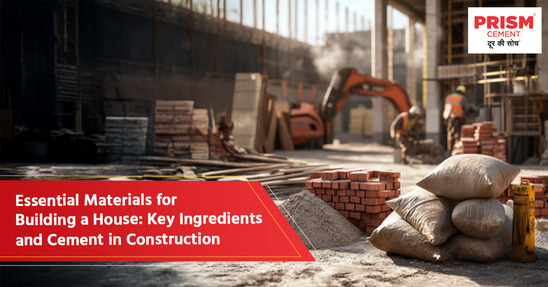The materials used to build a house play a vital role in its durability, energy efficiency and aesthetic appeal. Selecting the right materials, including key ingredients in construction cement and understanding their impact, is essential for creating a durable, sustainable and cost-effective home.
In this blog, we'll explore the traditional, modern and sustainable building materials used in residential construction, with an emphasis on construction techniques and cement plastering ratio.
Traditional Building Materials
Wood:
- Pros: Versatile, renewable and aesthetically pleasing
- Cons: Susceptible to fire, rot and insect damage
- Applications: Framing, flooring, roofing and interior finishes
Brick:
- Pros: Durable, fire-resistant and energy-efficient
- Cons: Labor-intensive to install and can be heavy
- Applications: Exterior walls, interior walls and chimneys
Concrete:
- Pros: Strong, durable and versatile
- Cons: Can be heavy and requires skilled labour for installation
- Applications: Foundations, slabs, walls and structural components
Note: Concrete comprises mainly of cement, that helps enhance strength and durability for foundational applications.
Stone:
- Pros: Durable, fire-resistant and aesthetically pleasing
- Cons: Heavy and labor-intensive to install.
- Applications: Foundations, exterior cladding and interior accent walls.
Modern Building Materials
Steel:
- Pros: Strong, durable and fire-resistant
- Cons: Susceptible to corrosion
- Applications: Structural frames, beams and columns
Glass:
- Pros: Allows natural light to enter, creating bright and airy spaces
- Cons: Can be fragile and energy inefficient
- Applications: Windows, doors and curtain walls
Prefabricated Materials:
- Pros: Faster construction time, reduced waste and consistent quality
- Cons: Limited design flexibility
- Applications: Walls, roofs and floors
Sustainable Building Materials
Bamboo:
- Pros: Renewable, strong and lightweight
- Cons: Limited availability in some regions
- Applications: Flooring, wall panels and furniture
Recycled Materials:
- Pros: Environmental friendly and cost-effective
- Cons: Can be less durable than traditional materials
- Applications: Insulation, flooring and countertops
Straw Bales:
- Pros: Excellent insulation properties and low cost
- Cons: Requires specialized construction techniques
- Applications: Wall and roof insulation
Factors to Consider When Choosing Building Materials:
- Durability and Longevity: Choose materials that can withstand the test of time and local climate conditions.
- Cost: Consider the initial cost of materials, such as cement and cement plastering ratio, as well as long-term costs like maintenance and energy efficiency.
- Energy Efficiency: Opt for materials that can help reduce energy consumption, such as high-performance insulation and energy-efficient windows.
- Environmental Impact: Choose materials with low environmental impact, such as recycled materials and sustainably sourced wood.
The choice of building materials depends on various factors, including budget, lifestyle, and environmental concerns. By carefully considering these factors, including the right cement ingredients and construction techniques, you can select the best materials to create a beautiful, sustainable, and comfortable home.
Remember to consult with a qualified architect or builder to determine the most suitable materials for your specific project, ensuring the main ingredient of cement and appropriate cement plastering ratio are applied for optimal results. We recommend Prism Cement for its wide range of high quality cement products, such as . Prism’s commitment to quality and sustainability ensures that its products deliver exceptional performance and contribute to greener buildings.




